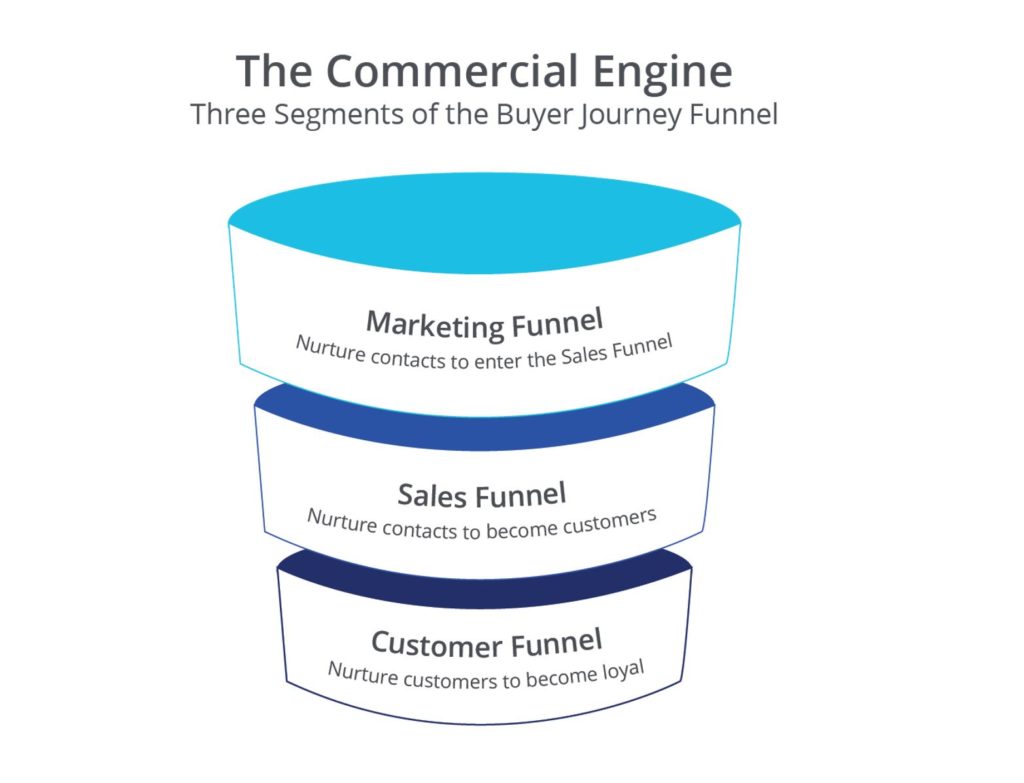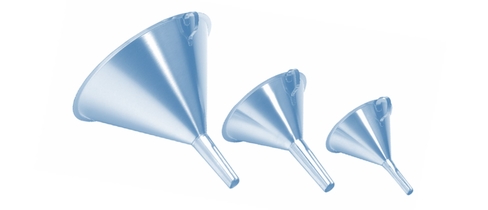[Part 1 of 3]
Listen to a discussion around finding prospects, nurturing leads, and closing business and you’ll find the talk will nearly always get around to funnels. The reference is usually to a “sales funnel.” The idea of this funnel is that you perpetually fill the wide end with many prospects and work these leads to deliver a portion of them out the other narrow end as customers.
For many years, I found the discussions about funnels leaving me somewhat off-balance and confused. Everyone concurred with the concept, but there was no general agreement on the definition of “the funnel.” Does the funnel start with prospects in your market who have not yet heard of you, or does it start when a prospect becomes a lead? Or, does it start when a lead is sales ready?
This blog is part 1 of a three-part blog series: Designing your Commercial Engine for Success
Part 1: Understanding the 3 Funnel Segments of your Commercial Engine
Part 2: Mapping the Buyer Journey to your Commercial Engine Funnel
Part 3: Aligning Lead Management, the Buyer Journey, and 3 Funnels
When the CEO asks for a funnel update, he or she is asking the sales team about the revenue forecast. Do we have enough sales opportunities approaching the point of closing to make the quarter revenue numbers? When the marketing team talks about the funnel, they are concerned with how many new leads have been generated and how many are sales ready. The service team looks at customer satisfaction and doesn’t normally consider they have a funnel at all.
The reality is that all three entities – sales, marketing, and service – are part of a larger unit in your organization called the Commercial Engine – the company’s system for obtaining leads, selling, and serving the customer. The commercial engine excludes things like manufacturing, HR, finance, IT, and facilities.
Sharing Ownership of the Overall Buyer Journey Funnel
In companies selling high dollar products, each of these three groups – marketing, sales, and service – owns a funnel segment. These three funnels are separate processes and you must focus on them individually to attract, close, and keep customers. Each funnel segment has its own purpose and needs.

Three Segments of the Buyer Journey Funnel
The Marketing Funnel Segment is managed by the marketing team and focuses on converting prospects in your target markets into leads. They must then nurture those leads to develop a high enough interest to warrant moving them into the sales funnel segment.
The Sales Funnel Segment is managed by the sales staff responsible for closing business. The purpose of this funnel segment is to convert people who are considering or are already in the buying cycle to make a purchase. Once the order is placed, they move to the customer funnel segment.
The Customer Funnel Segment is managed by your service and support staff and is responsible for retaining customers, obtain repeat orders, and converting as many customers as they can to become loyal. Loyal customers are far more valuable and more profitable than other customers – they buy all they can from you, are impervious to competition, and recommend you to others.
Smaller companies, due to fewer staff members, are more apt to combine funnel segments. I am a strong believer that even if one person is handling more than one funnel or you have a lot of bleed over between departments, you must separate the three segments of your commercial engine funnel system. Keep the functions, goals, and tracking of each segment separate so that you can maximize the performance of each.
Note regarding TOFU, MOFU, BOFU: Content marketing experts describe the 3-parts of the company funnel differently than I suggest here:
Top of Funnel (TOFU): Generating awareness from your total available market and obtaining subscriber leads.
Middle of Funnel (MOFU): Obtain a lead’s contact information, including a phone number, and qualify their interest. Then provide content and interactions targeted to their needs.
Bottom of Funnel (BOFU): You are selling a solution.
Although quite useful for mapping the buyer journey, these stages don’t span the entire commercial engine from lead gen to customer loyalty, nor are they named in a way as to clearly define departmental responsibility.
Funnel Segmentation Clarifies Responsibilities
When the three-funnel segment system is used as a structural blueprint for your commercial engine, you are better able to clarify responsibilities and deliver superior interactions with the marketplace. Such clarity also drives a culture of continuous improvement.
The marketing team benefits from owning their funnel segment because they gain clear marching orders to build awareness, obtain, qualify, and nurture leads to be sales ready. They can organize their CRM and nurturing programs to match these goals. I have seen companies assign the responsibility of qualifying leads to the sales staff responsible for closing business. I believe new lead qualification is the responsibility of marketing, not sales, for two primary reasons.
First, response time. When a new lead comes in, it is far easier for your company to respond quickly with an in-house marketing person than with a sales person often tied up traveling or in sales calls. Studies suggest responding to a new inquiry within five minutes of receiving the lead yields a 90 percent chance of reaching the inquirer. The rate drops off quickly to just 10 percent when the call is made in 30 minutes.
Second, the burning of leads. I have seen commission-based sales people dismiss low quality leads as useless, minimizing the value of nurturing the lead over time. It makes sense from their standpoint. They are paid (and pressured) to sell, and the company leadership makes a push for revenue (not lead nurturing) each month. In addition, sales people often feel that low-quality leads just clog up the CRM database. However, studies show companies that nurture leads generate 20% more sales ready leads, and a nurtured customer spends considerably more than a customer who comes to you as sales ready.
The sales team benefits from focusing on the sales funnel segment. Such focus enables them to only deal with contacts who are considering entering or are already in the buying cycle. They don’t have to switch gears many times during the day between low quality projects where the contact is only interested in learning and then back to high quality projects where they must work on obtaining detailed needs, scoping proposals, and negotiating quotations. This singular focus on landing business results in higher order win rates.
The service team benefits by understanding that they, too, are responsible for a funnel segment. They have a defined goal to obtain repeat customers and customer loyalty, which can drive a tremendous amount of continuous improvement. They will set up transactional KPIs that track customer satisfaction, and longer-term KPIs to track customer loyalty. Loyal customers are your most valuable asset, yet many companies put a disproportionate amount of focus on customer acquisition and little into deserving and obtaining customer loyalty. Creating a customer funnel segment will avoid this problem.
The leadership team also benefits from a three-funnel segment system by seeing the commercial engine as an integrated system where three areas must be managed. They no longer just focus on the quote conversion rate. A leadership team that pays attention to all three funnel segments will enjoy more predictability in the business and be in position to consistently push the company toward improvement and success.
Some might argue that structuring your commercial engine around three internal departments is an inward looking versus an outward looking approach. That may be true, but I have found that this division of responsibility between marketing, sales, and service aligns precisely with needs of the buyer as they move along the buyer journey path. Three funnels serve the buyers and customers better.
In Part 2 of this three-part blog series, I will explain how the three-funnel approach aligns with the buyer journey from lead to loyalty. Then, in Part 3, I’ll show you how I recommend aligning your lead management system to the funnel segments and the buyer journey, resulting in a fully integrated commercial engine that works with your CRM. Stay tuned.
Please send comments or questions or email me at cburnham@fairmontconcepts.com
chip
Latest posts by Chip Burnham (see all)
- Value Pricing Retains Both Customers and Profits - November 14, 2018
- Voice of the Customer – Needs Research - October 17, 2018
